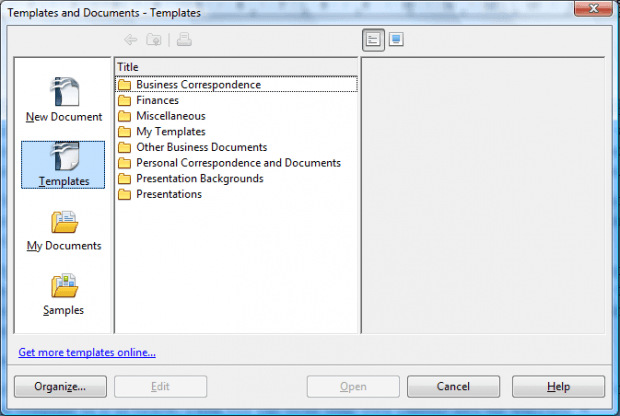
Open All Hyperlinks in an Outlook Email Message Use this script if you want to open a web page using a button on Outlook's ribbon.Ĭreate a Hyperlink on an Outlook Custom Form Set Items = Session.GetDefaultFolder(olFolderCalendar).Items For example, change the Set items line to this the following to create an appointment or meeting in the Calendar folder from any other folder: Use GetDefaultFolder function to use the default folder for the custom form type. You need to be viewing the folder you want the item to be saved in.
#Openoffice templates folder location code#
If you want to open a published form, use this code to call the form. Add it to your code after the line that opens the template (DUH!) and before the message is displayed ( newItem.Display). If you want to add an attachment to the message at the same time you open the template, you'll use "C:\myfile.doc". Set newItem = Application.CreateItem("C:\path\template.oft")Įnd Sub Open a Template and Add an Attachment If you open a contact, read an email then switch to the already-open contact, you will need to use the GetCurrentItem function on this page: Outlook VBA: Work with Open Item or Selected Item You can use it if a contact is open, as long as the contact is also the selected item. This macro works with the selected contact. This version of the macro will use a template to send a message to the selected contact. Set newItem = Application.CreateItemFromTemplate(template) Template = "C:\Users\Diane\Templates\email.oft" Template = "C:\Users\Diane\Templates\template1.oft" If you want to use a macro to open different templates, assign the template path to a variable and pass the variable to the macro, like this: See Customize the QAT if you need help customizing the QAT.
#Openoffice templates folder location how to#
See How to use the VBA Editor for complete instructions to use the VB Editor. Press Alt+F11 to open Outlook's VB Editor then copy and paste this macro into ThisOutlookSession.

Set newItem = Application.CreateItemFromTemplate("c:\path\template.oft") The solutionĬreate a macro that replicates opening a template from the Choose Form dialog using the Application.CreateItemFromTemplate method: These templates need to be opened using the Choose Form dialog. Note: if the template contains custom fields, the customizations will be disabled and the template will be blank. Additionally, opening a template hyperlinked to a toolbar button in Outlook 2007 brings up a security dialog. To create a button on the toolbar that will open a template in Outlook 2010 and up, you need to use a macro as it does not support hyperlink buttons found in older versions of Outlook. Use this registry value with Outlook 2010 and newer if you add files to Outlook's Shortcut navigation pane. See Disable the Unsafe Hyperlink Warning when Opening Attachments for the instructions to disable the warning dialog and the Open or Save dialog. To disable the warning message, you need to set a registry key. If you prefer to use a button on Outlook's toolbar, you can use a macro to open the template. To copy it to an Outlook folder, drag it to the desired folder. To pin a template, drag it from the template folder at C:\Users\%username%\AppData\Roaming\Microsoft\Templates and drop on the taskbar button.

Recently used templates that are not already pinned may be listed on the Outlook icon's right-click menu. Templates containing scripts or some controls must be opened using the Template dialog.Įmail templates that are pinned to the Outlook button on the taskbar are accessed by right-clicking on the Outlook button or you can copy the template to a folder in your Outlook data file. Pinned TemplatesĪll email templates and some calendar and contacts templates can be opened using these methods. If the template does not contain controls that require you to open it from the Template folder, you can store the template in other locations, including the Documents folder or Desktop pin it to the Outlook icon on the taskbar, or copy it into a folder in your Outlook data file.


 0 kommentar(er)
0 kommentar(er)
